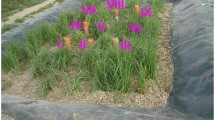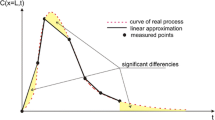Abstract
We have created a divided convective-dispersive transport (D-CDT) model that can be used to provide an accurate simulation of conservative transport processes in planted horizontal sub-surface flow constructed wetlands filled with coarse gravel (HSFCW-C). This model makes a fitted response curve from the sum of two independent CDT curves, which show the contributions of the main and side streams. The analytical solutions of both CDT curves are inverse Gaussian distribution functions. We used Fréchet distribution to provide a fast optimization mathematical procedure. As a result of our detailed analysis, we concluded that the most important role in the fast upward part of the tracer response curve is played by the main stream, with high porous velocity and dispersion. This gives the first inverse Gaussian distribution function. The side stream shows slower transport processes in the micro-porous system, and this shows the impact of back-mixing and dead zones, too. The significance of this new model is that it can simulate transport processes in this kind of systems more accurately than the conventionally used convective-dispersive transport (CDT) model. The calculated velocity and dispersion coefficients with the D-CDT model gave differences of 24–54 % (of velocity) and 22–308 % (of dispersion coeff.) from the conventional CDT model, and were closer to actual hydraulic behaviour.











Similar content being viewed by others
Abbreviations
- CW:
-
Constructed wetland
- FSCW:
-
Free-surface flow constructed wetland
- SFCW:
-
Sub-surface flow constructed wetland
- VSFCW:
-
Sub-surface flow constructed wetland with vertical flow direction
- HFSCW-C:
-
Horizontal sub-surface flow constructed wetland using coarse gravel filter media
- HRT:
-
Hydraulic retention time
- D (m2/h):
-
Dispersion coefficient
- D x (m2/h):
-
Longitudinal dispersion coefficient
- q (1/h):
-
Specific loading rate
- ε (−):
-
Porosity
- ε 0 (−):
-
Porosity of filter media
- x (m):
-
Longitudinal coordinate
- TSS (mg/l):
-
Total suspended solids
- CDT:
-
Convection-dispersion transport model
- CSTR:
-
Completely stirred tank reactor transport model
- LiCl:
-
Lithium-chloride
- C (mg/l):
-
Concentration
- w (m):
-
Width of seepage zone
- m (m):
-
Height of seepage zone
- t (h):
-
Time
- t elm (h):
-
Theoretical HRT
- M (g):
-
Mass of tracer
- v x (m/h):
-
Longitudinal velocity in porous regime
- L (m):
-
Length of seepage zone
- R (−):
-
Retention rate
- μ (s):
-
Mean of fitted C-t curve
- σ (s):
-
Standard deviation of fitted C-t curve
- a, b, c:
-
Parameters of inverse Gaussian distribution
- S/1, S/2, S/3 and S/4:
-
Reference numbers of own measurements
- N/1, N/2, N/3, N/4 and N/5:
-
The reference numbers of analysed international measurements
- Pe (−):
-
Pelcet number
- D-CDT:
-
Divided convective-dispersive transport model
- R 2 :
-
Statistical coefficient of determination
References
Batchelor A, Loots P (1996) Critical evaluation of a pilot scale subsurface flow wetland: 10 years after commissioning. Water Sci Technol 35(5):337–343
Blazejewski R, Murat-Blazejewszka S (1997) Soil clogging phenomena in constructed wetlands with subsurface flow. Water Sci Technol 35(05):183–188
Breen PF, Chick AJ (1995) Rootzone dynamics in constructed wetlands receiving wastewater: a comparison of vertical and horizontal format systems. Water Sci Technol 32(3):281–289
Chazarenc C, Merlin G, Yves G (2003) Hydrodynamics of horizontal subsurface flow constructed wetlands. Ecological Eng 21(2003):165–173
Dittrich E (2006) Experiences on hydraulic performance of sub-surface flow constructed wetlands. Pollack Period Akad Publ Budapest 1(1):53–66
Giraldi D, Michieli VM, Iannelli R (2010) A dynamic numerical model of subsurface vertical flow constructed wetlands. Environ Model Softw 25(2010):633–640
Goebes MD and Younger PL (2004) A simple analytical model for interpretation tracer test in two-domain subsurface flow systems. Mine Water Environ 23:138–143.
Govindaraju RS, Das BS (2007) Moment analysis for subsurface hydrologic applications, vol 61, Water science technology library. Springer, Netherland
Hua GF, Zhao ZW, Kong J, Guo R, Zeng YT, Zhao LF, Zhu QD (2014) Effects of plant roots on the hydraulic performance during the clogging process in mesocosm vertical flow constructed wetlands. Environ Sci Pollut Res. doi:10.1007/s11356-014-3249-1
Kadlec RH (1997) Deterministic and stochastic aspects of constructed wetland performance and design. Water Sci Technol 35(5):149–156
Kadlec RH (1999) Chemical, physical and biological cycles in treatment wetland. Water Sci Technol 40(3):37–44
Kadlec RH, Knight RL (1996) Treatment wetlands. Lewis Publishers, Baca Raton
Kickuth R (1977) Degradation and incorporation of nutrients from rural wastewater by plant rhizosphere under limnic conditions. In: Utilization of manure by land spreading. Comission of the E.C., London, pp 335–343
King AC, Mitchell CA, Howes T (1997) Hydraulic tracer studies in a pilot scale subsurface flow constructed wetland. Water Sci Technol 35(05):189–196
Knowles PR, Davies PA (2011) A finite element approach to modelling the hydrological regime in horizontal subsurface flow constructed wetlands for wastewater treatment. Water and Nutrient Management in Natural and Constructed Wetlands pp. 85–101. doi:10.1007/978-90-481-9585-5_8
Kovács B, Filep G, Lakatos J, Madarász T, Szabó I (2002) Remediation of contaminated sites. University of Miskolc, Hungary (in Hungarian)
Kumar JLG, Zhao YQ (2011) A review on numerous modelling approaches for effective, economical and ecological treatment wetlands. J Environ Manag 92:400–406
Langergraber G, Simunek J (2011) Hydrus 2D wetland module manual. PC-Progredd Eng Soft Dev
Langergraber G, Harberl R, Laber J, Pressl A (2003) Evaluation of substrate clogging processes in vertical flow constructed wetlands. Water Sci Technol 48(05):25–34
Langergraber G, Giraldi D, Mena J, Meyer D, Pena M, Toscano A, Brovelli A, Korkusuz A (2009) Recent developments in numerical modelling of subsurface flow constructed wetlands. Sci Total Environ 407:3931–3943
Levenspiel O (1972) Chemical reaction engineering. John Wiley and Sons Inc, New York
Netter R (1994) Flow characteristics of planted soil filter. Water Sci Technol 29(4):36–44
Rajabzadeh AR, Legge RL, Weber KP (2015) Multiphysics modelling of flow dynamics, biofilm development and wastewater treatment in a subsurface vertical flow constructed wetland mesocosm. Ecol Eng 74:107–116
Ranieri E (2003) Hydraulics of sub-superficial flow constructed wetlands in semi-arid climate conditions. Water Sci Technol 47(07–08):49–55
Rash JK, Liehr SK (1999) Flow pattern analysis of constructed wetlands treating landfill leachate. Water Sci Technol 40(3):309–315
Richter KM, Margets J, Saul AJ, Guymer I, Worrall P (2003) Baseline hydraulic performance of the Heathrow constructed wetlands subsurface flow system. Water Sci Technol 47(07–08):177–181
Samsó R, Garcia J (2013) BIO_PORE, a mathematical model to simulate biofilm growth and water quality improvement in porous media: application and calibration for constructed wetlands. Ecol Eng 54:116–127
Sani A, Scholz M, Babatunde A, Wang Y (2013) Impact of water quality parameters on the clogging of vertical-flow constructed wetlands treating urban wastewater. Water Air Soil Pollut 224:1488. doi:10.1007/s11270-013-1488-2
Schierup HH, Brix H, Lorenzen B (1990) Wastewater treatment in constructed reed beds in Denmark—state of the art, Constructed wetlands in water pollution control. Pregamon Press, Oxford
Shilton AN, Prasad JN (1996) Tracer studies of a gravel bed wetland. Water Sci Technol 34(3–4):421–425
Soto F, Garcia M, Bécares E (2000) Seasonal differences in removal efficiencies using Scirpus Lacustris for wastewater treatment. 7th International Conference on Wetland Systems for Water Pollution Control. Volume II. pp. 903–909
Tanner CC, Sukias JP (1995) Accumulation of organic solids in gravel-bed constructed wetlands. Water Sci Technol 32(3):229–239
Toscano A, Langergraber G, Consoli S, Cirelli GL (2009) Modelling pollutant removal in a pilot-scale two-stage subsurface-flow constructed wetlands. Ecol Eng 35:281–289
Wang J, Huang S, He C, Chiu-On NG (2011) Numerical analysis of the performance of horizontal and wavy subsurface flow constructed wetlands. J Hydrodyn 23(3):339–347
Winter KJ, Goetz D (2003) The impact of sewage composition on the soil clogging phenomena of vertical flow constructed wetlands. Water Sci Technol 48(05):9–14
Acknowledgments
The Katholieke Hogeschool Kempen, Geel (Belgium) began scientific cooperation with the Agricultural Faculty of the University of Szeged (Hungary) in 2003. One result of this cooperation is that the analysed natural wastewater treatment plant was built with scientific objectives. The project was financed by the Co-operation Programme between Flanders and Central and Eastern Europe, Department of Foreign Policy of the Flemish Government. More detailed information about the project is available at http://www.constructedwetlands.net/.
We express our thanks to our scientific supervisor, Ferenc Szilágyi, and to the Department of Water Utilities and Env. Eng. of the Budapest University of Technology and Economics.
Author information
Authors and Affiliations
Corresponding author
Additional information
Responsible editor: Marcus Schulz
Appendix
Appendix
Rights and permissions
About this article
Cite this article
Dittrich, E., Klincsik, M. Application of divided convective-dispersive transport model to simulate conservative transport processes in planted horizontal sub-surface flow constructed wetlands. Environ Sci Pollut Res 22, 18148–18162 (2015). https://doi.org/10.1007/s11356-015-4950-4
Received:
Accepted:
Published:
Issue Date:
DOI: https://doi.org/10.1007/s11356-015-4950-4




